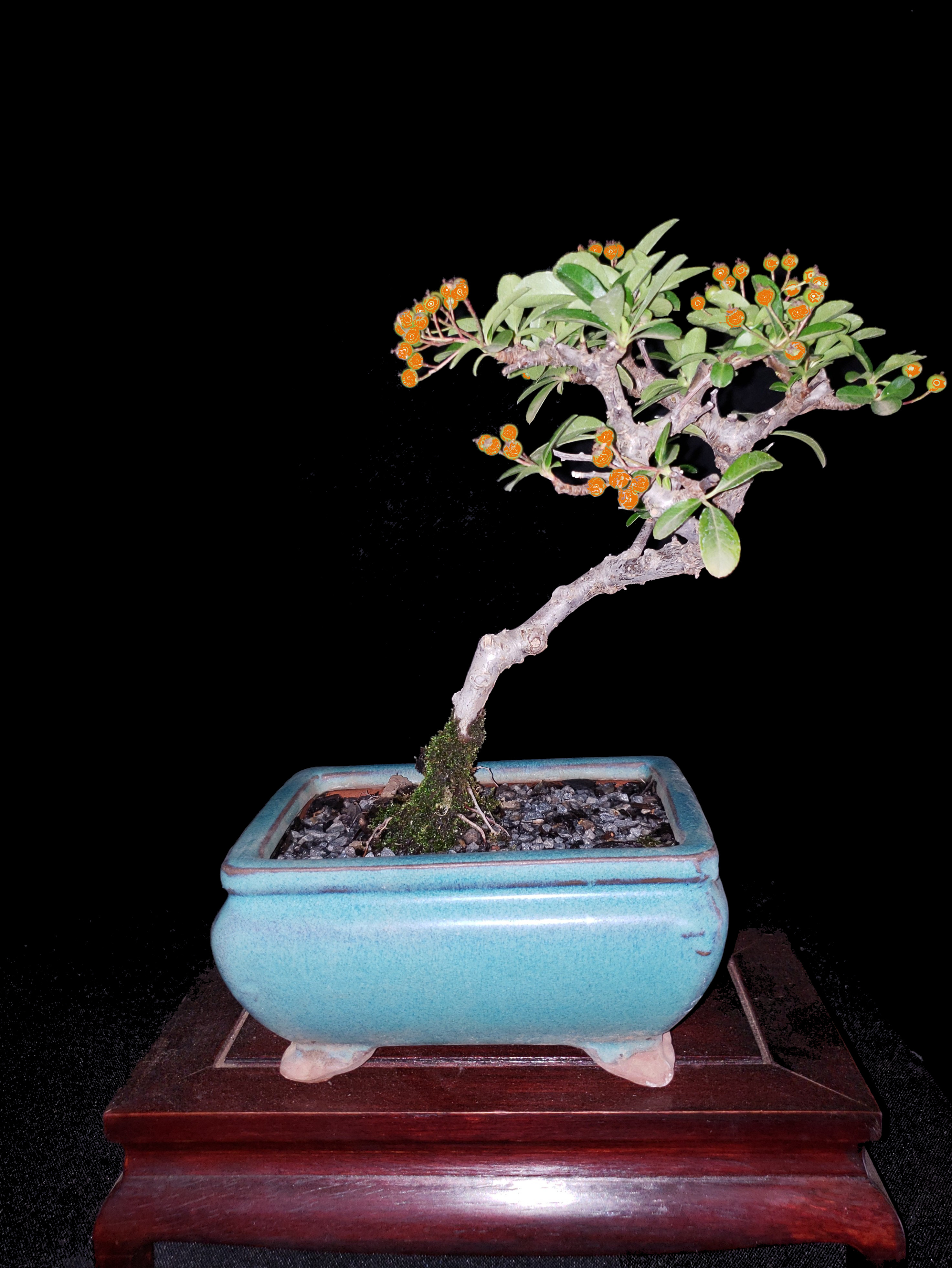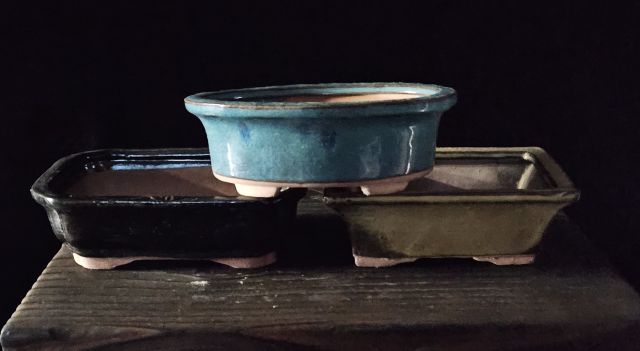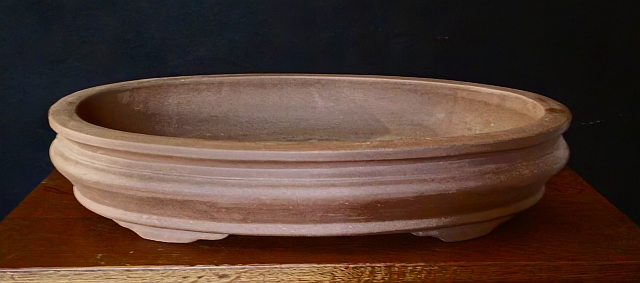UPCOMMING EVENTS / NOTICES
Our gate is closed for security. Please hoot at the gate to get our attention to open.
Mon - Fri 8am to 5pm
Sat 8am to 1pm
Sun Closed
NEXT BRAT MEETINGS

Firethorns on special @ R150ea
Selecting an appropriate container for a bonsai involves the similar decision making process, as the selection of a frame for a painting. In either case, the decisions made can enhance or detract from the final impact. Don't think the tree is the only feature, a viewer will see when they look at your creation. Your bonsai is not just the tree, but a whole presentation including, not only the plant material, but other elements as well.
What distinguishes a flower pot from a bonsai pots, is that a bonsai pot has feet and is usually less ornate.
In choosing a suitable pot for your tree, you should have to consider...
1. MATERIALS. Bonsai pots are made from various materials, but generally what is commonly available would be plastic, fiberglass, cement, mica and ceramic.
o Plastic pots are cheap and functional. They are light weight and come in a variety of colours and shapes. They serve a better function as growing and training pots being cost effective but the UV rays usually end up breaking the plastic of the container after 2-3 years.
o Fiberglass is a good alternative. Fiberglass is strong, light and comes in many colours. They tend to scratch easily, but are easily mended are very good alternatives to ceramic flat forest planters.
o Cement. Be aware of the lime leaching into your soil. Cement pots need to be prepared and sealed. Creating cement pots is within the reach of every bonsai enthusiast.
o Mica pots are made of 80% mica, 15% polyethelene and 5% graphite. Mica has a natural ability to stabilize the temperature of the soil in the pots. This promotes healthy root activity during the growing season and protects during the cold periods. These pots are extremely durable and will withstand the elements for years. They are extremely light in weight.
o Ceramic Pots
To have a clear definition, first, various kind of ceramic should be classified, by considering its construction and make. As a rough guide,
§ earthenware are normally fired at temperatures in the range of about 1000 to 1200 degrees Celsius. This is the most common form of bonsai pot.
§ Stoneware is fired at between about 1100 to 1300 degrees Celsius; and
§ porcelains at between about 1200 to 1400 degrees Celsius.
However, the way that ceramics mature in the kiln is influenced not only by the peak temperature achieved, but also by the duration of the period of firing. The higher the firing, the better the quality and the higher the price. Ceramics have an ability to warp and crack during firing. Thus flat, and large pots often tend to be difficult to complete and are subsequently costly.
o Marble/Granite although very porous allows for the creation of miniature landscapes.
1. POT SHAPE. The basic pot shapes are square, round, rectangular and oval. Coupled with the shape, the pot height, length and width will accentuate its shape. The pot may be flat – for suban, shallow for forest planters to tall for cascades. Lengths vary, to give space, negative and positive. Breadths vary to give depth.
2. POT STYLE. Pots are characterized by
2.1. Feminine characteristic would include smooth rounded corners, ornate inscriptions, fluted sides, dainty feet and glazing.
2.2. Masculine pots would include sharp corners, large lips, simple feet and unglazed.
However, such assessment is fairly subjective, and many pots have a mix of both femine and masculine characteristics.
3. POT SIZE For trees that are tall the width of the pot should be a little more than 2/3 the total height of the tree.
4. POT COLOUR Ceramic pots are either glazed, unglazed or painted. Unglazed pots come in the clay’s natural colour and are usually different shades of brown, but can vary to black, yellow, red and white. Glaze is a glassy coating applied to pottery, the primary purposes being, decoration and protection. Glazes are highly variable in composition but usually comprise a mixture of ingredients that generally, but not always, mature at kiln temperatures. One important use of glaze is in rendering pottery vessels impermeable to water and other liquids.
The colours and patterns involved are infinite, but there are a few pointers. All colours are made by mixing together varying proportions of 3 primary colours - red, yellow and blue. Mixing them in pairs creates three new secondary colours orange, green and violet, and further mixing creates tertiary colours. Then there are varying shades and undertones of these colours. The reds, as in light, are the warm colours while the blues are the cold colours.
The shape of the pot should complement the silhouette of the tree, which in turn enhances the style of the tree. One should look at either the pot or the tree, analyse it characteristics and them compliment or contrast the pot with tree and vice versa.
The tree is the focal point and trees that are too small in a pot will detract from the tree. Mathematically, where the tree is wider than it is tall, the container width should be equal to or less than 2/3 the spread of the crown. The width of the base of the tree should be about the height of the pot.
Feminine characteristics in a tree would be bonsai with flowers, berries, colourful or petite smooth leave, smooth bark texture, no visible root, oval crowns. With a feminine characteristics in a tree one would look for feminine characteristics in a pot.
Masculine characteristics would be trees with thorns, gins and sharis, little or no flowers and berries, serrated leaves, rough bark and a prominent nabari.
When looking for a glazed pot and unsure of what colour to use, you should stick to the earthly colours of green, brown and red.
Should you have a unique colour characteristic on your tree, such as red fruit, then you can either compliment the colour with a warm coloured pot of red or brown or you can contrast the colours with a blue pot. Should you choose to contrast colours, the colour trait of the tree must be significantly greater so that the pot does not detract away from the tree. Trees with these traits typically carry berries, flowers and colourful leaves. Very often it is simpler to stick to an unglazed natural colour. A tree in an unglazed container is always correct.
Trees with massive trunks will look better in heavy containers. Likewise, trees with lighter elements belong in lighter and more delicate pots. A cascade style bonsai belongs in cascade style pot and not in a shallow tray. Forest plantings look better and give a better feeling of depth when they are planted into low wide trays. A capable bonsai artist with a clear understanding of harmony, balance and negative space will probably arrive at these conclusions by himself.
Trees in bigger pots grow better than trees in smaller pots. The prime importance of bonsai is to sustain the life and health of the tree. Trees in deeper pots dry out exponentially slower than trees in shallow pots. Lighter pots are cooler than dark pots. This can be a good or bad factor, depending on the ambient temperature.
Sometimes we as bonsai artists are so focused on the placement of each branch that we forget to see the creations in containers that they might be potted in. A tree in the correct pot can have such a dramatic effect on the bonsai as a whole, changing it into something good to something of great beauty. What you must do is remember the prime directive... THE TREE IS THE POINT. By keeping things in focus, and taking a step back from our creations, we can insure that the selection of containers and accent items all make a positive contribution to our bonsai creation.
Finally, it is well to remember that the selection of a pot for your tree does not need to be an absolute one. Periodically changing the container your tree is potted in can give the planting an entirely new look and is completely at harmony with the way our trees themselves change throughout the seasons and years.
CHOOSING A POT
Pot Characteristics
Choosing a Pot
Visual Impact
Maintenance
Conclusion
We are a Bonsai Nursery, based in Midrand, Gauteng, South Africa. We import pots, tools and accessories directly, enabling us to give the lowest prices. We grow and style our own trees, species suitable to the High Veld environmental conditions. We supply and consult to bonsai clubs and growers, corporates, nurseries, weddings, promotional gift companies and individuals.



